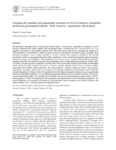Use este identificador para citar ou linkar para este item:
http://www.alice.cnptia.embrapa.br/alice/handle/doc/467800| Título: | Intraspecific variation and population structure of the velvetbean caterpillar, Anticarsia gemmatalis Hübner, 1818 (Insecta: Lepidoptera: Noctuidae). |
| Autoria: | SOSA-GOMEZ, D.R.  |
| Afiliação: | DANIEL RICARDO SOSA GOMEZ, CNPSO. |
| Ano de publicação: | 2004 |
| Referência: | Genetics and Molecular Biology, Ribeirão Preto, v. 27, n. 3. p. 378-384, 2004. |
| Conteúdo: | The velvetbean caterpillar (VBC), Anticarsia gemmatalis Hübner, 1818 (Insecta: Lepidoptera: Noctuidae), is one of the most important New World soybean agro-ecosystems pests, occurring from 40° N in the USA to 39° S in Argentina. Information on the migration patterns of the VBC moth may be important for managing the resistance of VBC populations to insecticides or plants carrying the Bacillus thuringiensis insecticide genes, especially since sedentary populations have a higher potential to became resistant than migratory populations. We studied intraspecific variations of geographically distinct VBC populations in order to determine the genetic distance between them and to assess the variability of VBC populations from near the city of Londrina (Paraná (PR) state, Brazil). Samples of the VBC were obtained from sites near the following towns or cities: Marianna and Quincy (Florida, USA); La Virginia (Tucumán province, Argentina); Londrina (PR), Passo Fundo (Rio Grande do Sul, Brazil) and Planaltina (Goiás, Brazil). The VBC samples were used to construct a genetic similarity matrix based on random amplified polymorphic DNA (RAPD) allele frequencies, the cotton leafworm, Alabama argillacea, Hübner 1823 (Insecta: Lepidoptera: Noctuidae), being used as an outgroup. Interestingly, despite the great distance (about 6,500 km) between Planaltina and Quincy some of the specimens from the Quincy population clustered in a group genetically close to the Planaltina populations. Larvae collected on peanuts in Marianna and on soybean in Quincy, 70 km apart, appeared genetically similar. The population from Planaltina was the most heterogeneous (polymorphism = 85.6%; heterozygosity = 0.1505). The Argentinean VBC population was entirely different from the Brazilian populations. The genetic similarities found between individuals from geographically distant populations and effective migration rate values (2.0566 > Nm < 15.2618) indicate that migration occurs. |
| Thesagro: | Soja |
| Tipo do material: | Artigo de periódico |
| Acesso: | openAccess |
| Aparece nas coleções: | Artigo em periódico indexado (CNPSO)  |
Arquivos associados a este item:
| Arquivo | Descrição | Tamanho | Formato | |
|---|---|---|---|---|
| ID24809.pdf | 120,3 kB | Adobe PDF |  Visualizar/Abrir |









